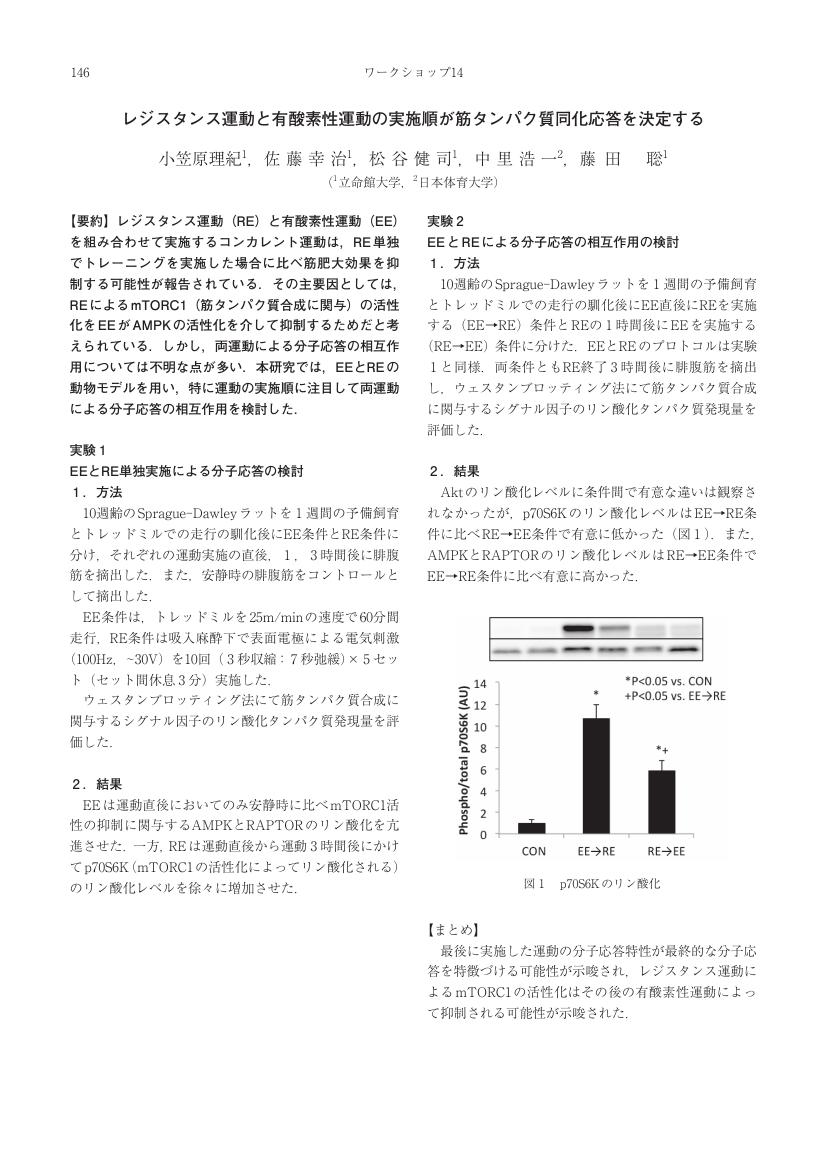22 0 0 0 OA レジスタンス運動と有酸素性運動の実施順が筋タンパク質同化応答を決定する
- 著者
- 小笠原 理紀 佐藤 幸治 松谷 健司 中里 浩一 藤田 聡
- 出版者
- 一般社団法人日本体力医学会
- 雑誌
- 体力科学 (ISSN:0039906X)
- 巻号頁・発行日
- vol.63, no.1, pp.146-146, 2014 (Released:2014-01-24)
4 0 0 0 OA 肉離れ損傷後の結合組織瘢痕形成の基礎的解析
2 0 0 0 OA 局所的筋運動による筋肥大効果転移のメカニズム:循環因子の探索
筋肥大を引き起こさない低負荷強度での上腕筋群のレジスタンストレーニングを、筋血流制限下での大腿筋のレジスタンストレーニングと組み合わせると、上腕筋群にも筋肥大が生じる(筋肥大の「交叉転移」: Madarame et al., 2008)。本研究では、この交叉転移における循環因子の役割を調べるために、ヒトおよびラットトレーニングモデルを用いて実験を行った。ヒトを対象としたトレーニング実験から、この交叉転移は、一般的な高負荷強度トレーニングによっても起こることが分かった。さらに、運動前後の血清をプロテオーム解析によって比較し、量的に差異のある複数の成長因子を同定した。一方、高強度トレーニングを負荷したラットの血清を培養筋芽細胞に添加したところ、筋タンパク質合成に関与するシグナル伝達系の活性化が見られた。これらの結果は、何らかの成長因子が循環因子として筋肥大の交叉転移に関わっていることを示唆する。
2 0 0 0 サルコペニアに伴う骨格筋の質的変化:メカニズムと有効な対策
- 著者
- 小谷 鷹哉 田村 優樹 中里 浩一 石井 直方
- 出版者
- 一般財団法人 日本健康開発財団
- 雑誌
- 日本健康開発雑誌 (ISSN:2432602X)
- 巻号頁・発行日
- vol.41, pp.79-86, 2020-06-19 (Released:2020-06-19)
- 参考文献数
- 15
背景・目的 筋力トレーニングによって骨格筋を肥大させることは、健康の保持・増進に重要である。本研究では、日本人が古くから習慣としてきた「入浴」が筋肥大効果を高める可能性に着目し、「筋力トレーニング後の入浴は筋肥大効果を高めるか?」を検証した。方法 本研究では、SDラットを「筋力トレーニング群」および「筋力トレーニング+入浴群」に分類し、左脚をコントロール脚とし右脚をトレーニング脚とした。筋力トレーニングについては、腓腹筋への電気刺激による等尺性収縮運動を10回×5セット行わせた。筋力トレーニングから3時間後に腓腹筋を摘出し、生化学分析を行った。結果・考察 骨格筋量は筋タンパク質合成と分解の出納バランスによって制御されることから、その両者を検討した。筋タンパク質合成の活性化において中心的な役割を担うmTORC1シグナル伝達系および筋タンパク質合成は、筋力トレーニングによって活性化されたが、入浴による影響は観察されなかった。筋タンパク質分解系において主要となるオートファジー系およびユビキチン系について、オートファゴソーム量の指標となるLC3-IIタンパク質量およびユビキチン化タンパク質量は筋力トレーニングにより有意に減少したが、入浴による影響は観察されなかった。これらの結果より、筋力トレーニング後の入浴は筋肥大効果を高めない可能性が示唆された。
1 0 0 0 OA 大学アメリカンフットボール選手の頚部筋力に関する研究
- 著者
- 津山 薫 藤城 仁音 中嶋 耕平 中里 浩一 中嶋 寛之
- 出版者
- The Japanese Society of Physical Fitness and Sports Medicine
- 雑誌
- 体力科学 (ISSN:0039906X)
- 巻号頁・発行日
- vol.48, no.2, pp.251-263, 1999-04-01 (Released:2010-09-30)
- 参考文献数
- 19
A study was conducted to evaluate and compare neck muscle strength between two levels of college American football players with the aim of preventing neck injuries. The subjects were American football players at N University (n=52) belonging to the first level league and American football players at G University (n=14) belonging to the third level league. The findings were as follows.1. The neck muscle strength of freshman players at N University tended to be lower than that of senior players.2. It was shown that the neck muscle strength/body weight of experienced American football players was 10-30% higher than that of inexperienced players.3. There was a significant difference in neck muscle strength/body weight between N University and G University in 1997. However, there was no significant difference between them in 1998, because neck muscle strength/body weight of G University players increased by 13-30% after neck muscle training for about nine months. It was suggested that coaching staff must evaluate the neck muscle strength of each player, especially in freshmen who have had no experience of American football, in order to prevent neck injuries because mismatch of performance level may cause catastrophic neck injury.
1 0 0 0 椎間板変性を有する大学女子体操競技選手の身体的特徴
- 著者
- 小山 浩司 中里 浩一 具志堅 幸司 畠田 好章 瀬尾 京子 閔 石基 宋 石縁 平沼 憲治
- 出版者
- 日本臨床スポーツ医学会
- 雑誌
- 日本臨床スポーツ医学会誌 = The journal of Japanese Society of Clinical Sports Medicine (ISSN:13464159)
- 巻号頁・発行日
- vol.19, no.3, pp.591-597, 2011-08-31
1 0 0 0 大学男子レスリング競技者における頚椎椎間板変性と身体特性の関連性
- 著者
- 立間 俊宏 中里 浩一 松本 慎吾 小山 浩司 宋 石縁 平沼 憲治
- 出版者
- 日本臨床スポーツ医学会
- 雑誌
- 日本臨床スポーツ医学会誌 = The journal of Japanese Society of Clinical Sports Medicine (ISSN:13464159)
- 巻号頁・発行日
- vol.21, no.3, pp.602-610, 2013-08-31
1 0 0 0 腰痛を有する大学陸上競技選手の身体的特徴
- 著者
- 齋藤 義信 岩井 一師 中里 浩一 入江 一憲 水野 増彦 中嶋 寛之
- 出版者
- 日本体力医学会
- 雑誌
- 体力科學 (ISSN:0039906X)
- 巻号頁・発行日
- vol.58, no.1, pp.99-108, 2009-02-01
- 被引用文献数
- 1 1
The purpose of this study was to clarify physical characteristics related to low back pain (LBP) in collegiate track and field athletes. We particularly focused on the nature of the track and field. The subjects were 21 male collegiate track and field athletes including only sprinters, hurdlers, long jumpers and triple jumpers. The examined parameters were physical characteristics, isokinetic flexor and extensor strength in the knee and trunk regions. The evaluation of LBP was estimated by a questionnaire test and orthopedic surgeons' diagnosis. According to these evaluations, we divided all track and field athletes into two groups ; LBP group (n=11, 52.4%) and no LBP group (n=10, 47.6%). As a result, a take-off leg of knee flexor/extensor strength ratio in the LBP group was significantly lower than that in the no LBP group (P<0.05). The LBP group showed a significant difference between a take-off leg and a lead leg in knee flexor strength compared with the no LBP group (P<0.05). The LBP group has been short engaged in the track and field than the no LBP group (P<0.05). In the trunk flexor and extensor strength, there was no significant difference between the LBP and the no LBP group in this study. These results suggest that the imbalanced knee muscle strength may be one of some factors related to chronic low back pain in collegiate track and field athletes.
1 0 0 0 OA 柔道競技者における動的な頚部筋力トレーニングが頚部の筋力と筋断面積に及ぼす効果
- 著者
- 津山 薫 山本 洋祐 中里 浩一 中嶋 寛之
- 出版者
- 日本体力医学会
- 雑誌
- 体力科學 (ISSN:0039906X)
- 巻号頁・発行日
- vol.54, no.3, pp.249-258, 2005-06-01
- 被引用文献数
- 3 2
The purpose of this study was to examine the effects of dynamic neck muscle training using a cervical extension machine (CEM) on isometric cervical extension strength (ICES) and a cross-sectional area of neck extensor muscles. Subjects were 18 male college judo athletes divided into a control group (n=10) and training group (n=8), respectively. In the training group, dynamic neck muscle training was performed for a 6 week training period, followed by a 10 week training period. There was a detraining period of 12 weeks between the first training period and the second. The ICES was measured at eight angles using a CEM, and the neck muscle cross-sectional area was determined using magnetic resonance imaging. The ICES and cross-sectional area of neck extensor muscles in the training group showed significant increases after the second training period. In particular, the increase in the cross-sectional area was greater in the deepest layer of the neck extensor muscles (rotator, multifidus and semispinaris cervicis muscles) than in the superficial layer (trapezius muscle). In the control group, no significant changes in ICES or cross-sectional area were observed. In conclusion, it was shown that dynamic neck muscle training using a CEM was effective in developing both ICES and the cross-sectional area of neck extensor muscles, especially in the deepest layer.


